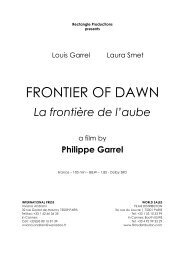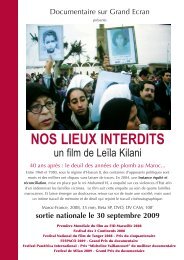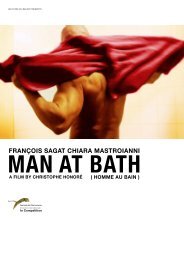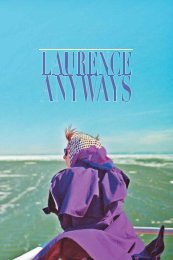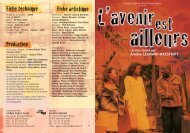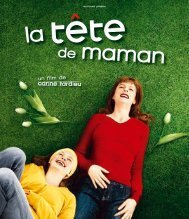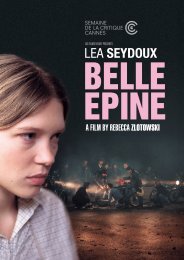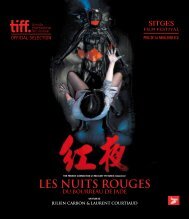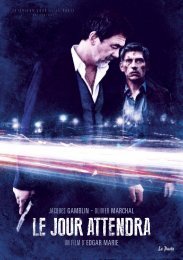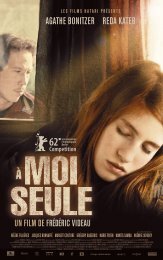pascal greggory jonathan zaccaï alexandra maria lara ... - Unifrance
pascal greggory jonathan zaccaï alexandra maria lara ... - Unifrance
pascal greggory jonathan zaccaï alexandra maria lara ... - Unifrance
- No tags were found...
Create successful ePaper yourself
Turn your PDF publications into a flip-book with our unique Google optimized e-Paper software.
ENTRE CHIEN ET LOUP SAMSA FILM ARCHIPEL 35 PALLAS FILM PRÉSENTENT<br />
!"#$%#$&#$'()*+,-$.+-$<br />
6<br />
'#$/0#*1+%2#$+3#%*)1#$4),$&0+**#%'+,*555!<br />
6<br />
'0+.1#-$/#$&+%2+$7)/*#<br />
'#$",1($*+%,2)78,<br />
9<br />
PASCAL GREGGORY JONATHAN ZACCAÏ<br />
ALEXANDRA MARIA LARA LÉO LEGRAND<br />
MUSIQUE ORIGINALE AIR<br />
AVEC LA PARTICIPATION DE EVELYNE DIDI SOPHIE DUEZ LIONEL ABELANSKI TANIA GARBARSKI IMAGE JEANNE LAPOIRIE A.F.C. SON CARLO THOSS PIA DUMONT THOMAS GAUDER<br />
DIRECTION ARTISTIQUE VÉRONIQUE SACREZ MONTAGE LUDO TROCH PRODUCTEURS DIANA ELBAUM DENIS FREYD JANI THILTGES THANASSIS KARATHANOS KARL BAUMGARTNER<br />
SÉBASTIEN DELLOYE UNE PRODUCTION ENTRE CHIEN ET LOUP SAMSA FILM ARCHIPEL 35 PALLAS FILM EN COPRODUCTION AVEC LES ATELIERS DE BAERE RTBF (TÉLÉVISION BELGE)<br />
RHÔNE-ALPES CINÉMA EN ASSOCIATION AVEC WILD BUNCH AVEC LE SOUTIEN DU FONDS NATIONAL DE SOUTIEN À LA PRODUCTION AUDIOVISUELLE DU GRAND-DUCHÉ DE LUXEMBOURG<br />
DU CENTRE DU CINÉMA ET DE L’AUDIOVISUEL DE LA COMMUNAUTÉ FRANÇAISE DE BELGIQUE ET DES TÉLÉDISTRIBUTEURS WALLONS DE EURIMAGES<br />
UN FILM DE SAM GARBARSKI<br />
SCÉNARIO ADAPTATION ET DIALOGUES<br />
JÉRÔME TONNERRE SAM GARBARSKI PHILIPPE BLASBAND<br />
D’APRÈS HARUKANA MACHI’E DE JIRÔ TANIGUCHI<br />
AVEC LA PARTICIPATION DE CANAL+ CINÉCINÉMA TPS STAR MITTELDEUTSCHE MEDIENFÖRDERUNG GMBH<br />
MEDIENBOARD BERLIN-BRANDENBURG LA RÉGION WALLONNE EN ASSOCIATION AVEC BANQUE POPULAIRE<br />
IMAGES 10 AVEC LE SOUTIEN DU PROGRAMME MEDIA DE LA COMMUNAUTÉ EUROPÉENNE ET DE I2I AUDIOVISUAL<br />
DE LA PROCIREP ET DE L’ANGOA-AGICOA DU TAX SHELTER DU GOUVERNEMENT FÉDÉRAL BELGE<br />
DE DREAM TOUCH DE CASA KAFKA PICTURES ET DE TAXSHELTER.BE VENTES INTERNATIONALES WILD BUNCH<br />
quartier lointain_120x160_sans ana.indd 1 11/10/10 16:18:48
ENTRE CHIEN ET LOUP, SAMSA FILM,<br />
ARCHIPEL 35, PALLAS FILM<br />
PRE S E NT<br />
PASCAL GREGGORY JONATHAN ZACCAÏ ALEXANDRA MARIA LARA LÉO LEGRAND<br />
in<br />
A DISTANT<br />
NEIGHBORHOOD<br />
A film by SAM GARBARSKI<br />
Screenplay by<br />
JÉRÔME TONNERRE, SAM GARBARSKI, PHILIPPE BLASBAND<br />
Adapted from “HARUKANA MACHI’E” by JIRÔ TANIGUCHI<br />
© Jirô Taniguchi / Shogakukan Inc.<br />
Published by Shogakukan, Inc. Tokyo.<br />
French Edition “Quartier Lointain” published by Casterman<br />
Original Music by AIR<br />
2010 · FRAN C E · RUNNIN G TIME 1H38 MINS · 35 MM · 1.85 · D O LBY SR-SRD · C O L O UR<br />
PLEASE NOTE: Photos and press kit can be downloaded from www.wildbunch.biz<br />
French official website: www.quartierlointain.com
SYNOPSIS<br />
Thomas, a father in his fifties, returns by chance<br />
to the town where he grew up. He collapses and<br />
wakes up forty years earlier in the body of his<br />
teenage self. Thrown back into his past, Thomas will<br />
not only have to re-live his first love, but also try to<br />
understand the reasons for his father’s mysterious<br />
departure. C an you change the past by living it<br />
again?
CAST<br />
Thomas (as an adult)<br />
Bruno<br />
Anna<br />
PASCAL GREGGORY<br />
JONATHAN ZACCAÏ<br />
ALEXANDRA MARIA LARA<br />
Thomas (as a teenager)<br />
Sylvie<br />
C orinne<br />
Rousseau<br />
Nelly<br />
Rachel<br />
Godin (as a teenager)<br />
LÉO LEGRAND<br />
LAURA MARTIN<br />
LAURA MOISSON<br />
PIERRE-LOUIS BELLET<br />
TANIA GARBARSKI<br />
LAURENCE LIPSKI<br />
LOUIS BIANCHI<br />
Anna<br />
C habrot<br />
Jules<br />
Emma<br />
Alice<br />
Supervisor<br />
C ontroller<br />
Latin teacher<br />
Maths teacher<br />
Teenager at<br />
C omic C onvention<br />
Dr Dumontel<br />
ALEXANDRA MARIA LARA<br />
THÉO DARDENNE<br />
AUGUSTIN LEPINAY<br />
PAULINE CHAPPEY<br />
JULIETTE LEMBROUK<br />
JEAN-FRANÇOIS WOLFF<br />
CHARLIE DUPONT<br />
JACQUES BERENBAUM<br />
ODILE MATHIEU<br />
CLÉMENT CHEBLI<br />
PATRICK ZIMMERMANN<br />
SPE C IAL G UEST APPEARAN C ES:<br />
Mémé Yvette<br />
C atherine<br />
Godin (as an adult)<br />
EVELYNE DIDI<br />
SOPHIE DUEZ<br />
LIONEL ABELANSKI
CREW<br />
Directed by<br />
SAM GARBARSKI<br />
Screenplay<br />
JÉRÔME TONNERRE, SAM GARBARSKI and<br />
PHILIPPE BLASBAND.<br />
Adapted from “HARUKANA MACHI’E”<br />
by JIRÔ TANIGUCHI © JIRÔ TANIGUCHI /<br />
SHOGAKUKAN INC.<br />
Published by SHOGAKUKAN, INC. TOKYO.<br />
French Edition QUARTIER LOINTAIN published<br />
by CASTERMAN<br />
Original Music<br />
AIR (JEAN-BENOÎT DUNCKEL and NICOLAS<br />
GODIN)<br />
DP<br />
JEANNE LAPOIRIE A.F.C.<br />
Sound<br />
CARLO THOSS<br />
Production Designer<br />
VÉRONIQUE SACREZ<br />
C ostume Designer<br />
ANAÏS ROMAND<br />
Hair and Make-up<br />
KATJA REINERT<br />
Editor<br />
LUDO TROCH<br />
Sound Editor<br />
PIA DUMONT<br />
Sound Designer<br />
THOMAS DESJONQUERES<br />
Mix<br />
THOMAS GAUDER<br />
C olour Grader<br />
PETER BERNAERS<br />
Production<br />
BRIGITTE KERGER-SANTOS<br />
C asting<br />
NATHANIÈLE ESTHER<br />
Producers<br />
DIANA ELBAUM<br />
DENIS FREYD<br />
JANI THILTGES<br />
THANASSIS KARATHANOS<br />
KARL BAUMGARTNER<br />
SÉBASTIEN DELLOYE<br />
Production C ompanies<br />
ENTRE CHIEN ET LOUP (Belgium)<br />
ARCHIPEL 35 (France)<br />
SAMSA FILM (Luxembourg)<br />
PALLAS FILM (Germany)<br />
In coproduction with<br />
LES ATELIERS DE BAERE<br />
RTBF (TÉLÉVISION BELGE)<br />
RHÔNE-ALPES CINÉMA<br />
In association with<br />
WILD BUNCH<br />
With the support of<br />
FONDS NATIONAL DE SOUTIEN À LA<br />
PRODUCTION AUDIOVISUELLE DU GRAND<br />
DUCHÉ DE LUXEMBOURG<br />
CENTRE DU CINÉMA ET DEL’AUDIOVISUEL DE<br />
LA COMMUNAUTÉFRANÇAISE DE BELGIQUE<br />
ET DES TÉLÉDISTRIBUTEURS WALLONS<br />
EURIMAGES<br />
With the participation of<br />
CANAL +<br />
CINÉCINÉMA<br />
TPS STAR<br />
MITTELDEUTSCHE MEDIENFÖRDERUNG<br />
GMBH<br />
RÉGION RHÔNE-ALPES AND THE CENTRE<br />
NATIONAL DE LA CINÉMATOGRAPHIE<br />
MEDIENBOARD BERLIN-BRANDENBURG<br />
RÉGION WALLONNE<br />
In association with<br />
BANQUE POPULAIRE IMAGES 10<br />
With the support of<br />
THE MEDIA PROGRAMME OF THE EUROPEAN<br />
COMMUNITY and I2I AUDIOVISUAL<br />
PROCIREP and ANGOA-AGICOA<br />
MJD DÉVELOPPEMENT<br />
TAX SHELTER OF THE GOUVERNEMENT<br />
FÉDÉRAL BELGE<br />
DREAM TOUCH<br />
CASA KAFKA PICTURES<br />
TAXSHELTER.BE<br />
Thomas’ drawings<br />
FRANK PÉ
A conversation with<br />
JIRÔ TANIGUCHI and<br />
SAM GARBARSKI<br />
Jirô Taniguchi, how did you get the idea for<br />
A Distant Neighborhood?<br />
Jirô Taniguchi: It all started with a strange dream, in<br />
which I went back to my childhood and succeeded in<br />
declaring my feelings to the young girl I was in love<br />
with in college. I developed that idea: the possibility<br />
of returning to your childhood in your childhood body<br />
while keeping your adult mind. With, of course, all the<br />
consequences that implied but mostly one nagging<br />
question: if I went back in time would I be able to use<br />
what I know now to change the future?<br />
Since it was published in 2002 your book<br />
has enjoyed enormous success in France<br />
and throughout Europe. How do you explain<br />
this widespread enthusiasm from a western<br />
audience?<br />
J.T.: Frankly, I have no idea. I’ve asked myself this<br />
question many times but it remains a marvellous mystery.<br />
In Japan, A Distant Neighborhood was awarded a<br />
prize by the Ministry of Culture but has not enjoyed<br />
such public success. What’s even more amazing to<br />
me is that it is set at the beginning of the sixties in a<br />
very Japanese context. I imagined my typical reader<br />
similar to Hiroshi, the main character: a middle-ranking<br />
executive in his forties like so many in Tokyo. The fact<br />
that Belgians, French or Italians can understand and<br />
appreciate a world so different to their own was both a<br />
great joy and a revelation.<br />
Sam Garbarski, why did you want to adapt this<br />
story for the big screen?<br />
Sam Garbarski: It is not my story yet it is very much<br />
my story! Even though A Distant Neighborhood is set<br />
in a world so remote from ours, this manga conveys<br />
universal values and feelings. Everyone can identify with<br />
Hiroshi’s character, and let themselves be transported<br />
with him on his journey. All the more so as Taniguchi<br />
has succeeded in creating a strange, poetic climate.<br />
The formal aspect is crucial here: the production, the<br />
perfect framing, the sets, all bring a true depth, and of<br />
course there is the “mâ”, the suspended moment where<br />
everything is said without a word. The real challenge<br />
was not to transpose the story to France but to render<br />
the aesthetics as well as possible in the film. Decency,<br />
emotion and restraint were the key words I imposed<br />
upon myself in the telling of this story.<br />
What did you have to change from the original<br />
story to adapt it to film?<br />
S.G.: The danger was remaining a slave to the original<br />
work, being afraid of touching it. But a comic is not<br />
a storyboard. Even if the storytelling is perfect on<br />
paper it cannot simply be transposed to the screen.<br />
I made the story mine little by little by changing certain<br />
details but mostly by re-centring its dramatic impulse<br />
on the father’s leaving. I intentionally inserted a few<br />
“madeleines”: scenes that I’d lived myself, objects<br />
that I hold dear. There’s my father’s watch, his car, the<br />
kind of polo shirts he used to wear, the way he used<br />
to hold a glass… He’s dead now but I love him so<br />
much it suffocates me sometimes. I dedicated this film<br />
to him. I would like the audience to leave the theatre<br />
uncertain whether the story has taken place or not.<br />
Has Thomas travelled in time or did he imagine it all?<br />
Without indulging in cheap psychobabble, you could<br />
see A Distant Neighborhood as analytical work to<br />
some degree, not with the couch but with a pen.<br />
Jirô Taniguchi, what surprised you most in the<br />
screenplay?<br />
J.T.: The fact that the main character became a mangaka.<br />
I was concerned that such a specific profession could<br />
create difficulties in the unfolding of the story. But after<br />
I saw the film I even forgot it wasn’t in the original story!<br />
The young girl he’s in love with is quite different as well.<br />
In the screenplay she’s more assertive, wittier, not at<br />
all passive, and I have to admit that it works very well.<br />
The original manga is marked by the post-War context<br />
in Japan and I really love the fact that the screenplay has<br />
taken that into account and succeeded in transposing<br />
it to France.<br />
What impressions have you kept from the film?<br />
What touched you most?
J.T.: The film has transcribed my work in a more<br />
aesthetic manner than in the original manga. The<br />
story unfolds with appropriate suspense, there’s a<br />
real tension from beginning to end. The role of the<br />
soundtrack gave me a lot to think about. The original<br />
score by Air accentuated each character’s feelings,<br />
adding a truly artistic dimension. I was stunned by the<br />
strength of the scenery. Nantua Lake and the foothills<br />
of the Alps were magnificent and play an important role.<br />
It’s the kind of landscape that accentuates feelings and<br />
allows storytelling to unfold without too many words.<br />
The whole film is outstanding but one scene stands out<br />
for me: the reunion of father and son. There’s also the<br />
poignant scene - not in my manga - where Thomas,<br />
wrapped up in a white sheet, throws himself into his<br />
mother’s arms.<br />
If like Thomas you could re-live the year you<br />
turned fourteen, what would you do?<br />
J.T.: I think I’d gather the courage to approach that girl<br />
and finally declare my love for her (laughs). I think I’d<br />
also study more and improve my culture. I would still<br />
be a mangaka, but I’d allow myself more time before<br />
I entered the job market. I also realize that at that age<br />
there were a lot of things I would have liked to tell my<br />
parents but that was beyond my capabilities at the time.<br />
And in the end, it’s fine this way! It could be the lesson<br />
of this story. It is by discovering that he cannot change<br />
the course of life that Hiroshi makes progress.<br />
S.G.: I would probably not change anything; that’s<br />
what gives the story its beauty. Or perhaps some small<br />
details, but I wouldn’t touch the essence. Fourteen is<br />
when you become aware of many things, when they<br />
are felt differently because you’re in the process of<br />
becoming an adult. In fact, I would like to re-live it all.
SAM GARBARSKI<br />
Filmography<br />
1998 LA DIN DE (short)<br />
2000 LA VIE, LA M O RT, LE F O OT (short)<br />
2001 MERRY C HRISTMAS, RAC HID (short)<br />
2003 TH E RAS H EVSKI TAN G O<br />
2007 IRINA PALM<br />
2010 A DISTANT N EIG H B O RH O O D
JIRÔ TANIGUCHI<br />
Biography<br />
Jirô Taniguchi was born August 14, 1947 in Tottori.<br />
He made his manga debut in 1971 with A Dessicated<br />
Summer. From 1976 to 1996, with scenarist Natsuo<br />
Sekikawa, he published City Without Defence, The<br />
Wind of the West and Lindo 3. The five volumes of<br />
Bocchan no jidai followed. From 1991, Jirô Taniguchi<br />
created a number of solo albums, including The<br />
Walking Man, The Almanac of my Father and A Distant<br />
Neighborhood. In 2004, Keyaki no Ki, a collection of<br />
novels adapted from the works of Ryuchiro Utsumi,<br />
appeared, and was followed in 2006 by The Ice<br />
Wanderer.<br />
Jirô Taniguchi is the recipient of numerous major awards<br />
worldwide.<br />
Selected Bibliography<br />
(works translated into English)<br />
A DISTANT N EIG H B O RH O O D<br />
IC AR O PART 1 B O O K 1 (with M O E BIUS)<br />
SAMURAI LE G E N D<br />
SKYHAWK<br />
SUMMIT O F TH E G O DS<br />
TH E IC E WAN DERER<br />
TH E MAG IC M O UNTAIN<br />
TH E TIMES O F B OTC HAN<br />
TH E WALKIN G MAN<br />
Z O O IN WINTER
PHILIPPE BLASBAND (Co-writer)<br />
JÉRÔME TONNERRE (Co-writer)<br />
I bought A Distant Neighborhood the day it was<br />
published in Belgium, and as soon as I finished reading<br />
it I immediately thought of Sam. Even though it was<br />
set in Japan in the sixties I knew this was a story for<br />
him: the era and most of all the emotions were very<br />
close to those he experienced. In fact I remembered<br />
an old photograph I saw at his house, taken when he<br />
was a teenager: he’s surrounded by a bunch of friends,<br />
they’re all looking at the camera, he’s looking at a girl<br />
who is blushing... In my screenplays I always try to<br />
strike an autobiographical chord.<br />
Why locate the film in France? Because it would have<br />
been simply impossible in Belgium! First of all it’s set in<br />
the sixties and at that time - every sound archive proves<br />
it - the Belgian accent as spoken by the average Belgian,<br />
or even by a university professor, was really very strong,<br />
so not easy to export! Our landscapes do not allow for<br />
mountains to use as background whereas Nantua is<br />
completely surrounded by peaks, you can never see<br />
the horizon there and that creates a very particular<br />
atmosphere. There is also the fact that Belgium is so<br />
small, it’s impossible to find yourself stuck somewhere<br />
like Thomas - you can always call a cab!<br />
Sam and Philippe were confronted with a real puzzle.<br />
In the manga, the return to the past takes place over a<br />
few years. Then, in the middle of the narrative, the hero<br />
realizes that he has come back the same year his father<br />
mysteriously disappeared. That’s fine in a comic strip<br />
but completely out of the question in a film! It’s not a<br />
twist, it’s a 180 degree turn, another story. I suggested<br />
that Thomas should remember from the start the event<br />
that is going to mark his whole life. It seemed more<br />
plausible to me. As soon as he’s back in his past he is<br />
haunted by this thought; his character becomes more<br />
introverted, more contemplative. By the same token we<br />
didn’t dwell on his life in college: our ambition was not<br />
to Americanize the Japanese manga in a bad remake<br />
of Back to the Future or Peggy Sue Got Married.<br />
We also fleshed out the character of the father. In<br />
the original story he’s a somewhat uncouth man, who<br />
disappears almost without any explanation. He had<br />
to become more complex, more human. In Japan, A<br />
Distant Neighborhood was pre-published as a serial.<br />
Each chapter is a complete story in its own right. The<br />
great difficulty was to give unity to the whole project,<br />
to stay faithful to these small miracles of freshness and<br />
simplicity while discreetly weaving an invisible thread.<br />
Because Taniguchi uses film techniques a lot I thought<br />
that A Distant Neighborhood would be easy to adapt,<br />
a little like a Simenon novel. I was wrong! C ausality<br />
is different in comics, there are a lot of conventions,<br />
ellipses between panels that the reader accepts but<br />
that cannot be conveyed on the big screen. It took us<br />
three years of work before we were able to find the<br />
right screenplay. And the support of Jérôme Tonnerre<br />
to get through it.
CAST - Selected Filmographies<br />
PASCAL GREGGORY<br />
2005 G AB RIELLE - Patrice Chéreau<br />
2006 TH E PAG E TURN ER - Denis Dercourt<br />
PARD O N N E Z-M OI - Maïwenn<br />
2007 LA VIE E N R O SE - Olivier Dahan<br />
LA FRAN C E - Serge Bozon<br />
2009 RE B E C C A H - Lodge Kerrigan<br />
THIS NIG HT - Werner Schroeter<br />
TH E ACTRESS’ BALL - Maïwenn<br />
C LARA - Helma Sanders-Brahms<br />
TH E O RDINARY PE O PLE - Mathias Gokalp<br />
2010 LE MARIAG E À TR OIS - Jacques Doillon<br />
SW E ET EVIL - Olivier C oussemacq<br />
A DISTANT N EIG H B O RH O O D<br />
- Sam Garbarski<br />
JONATHAN ZACCAÎ<br />
2005 TH E B EAT THAT MY H EART SKIPPE D<br />
- Jacques Audiard<br />
E NTRE SES MAINS - Anne Fontaine<br />
2006 TOI ET M OI - Julie Lopes-Curval<br />
2007 ILL WIN D - Stéphane Allagnon<br />
R O O M O F DEATH - Alfred Lot<br />
2008 LES YEUX BAN DÉS - Thomas Lilti<br />
2009 PRIVATE LESS O NS - Joachim Lafosse<br />
SIM O N KO NIANSKI - Micha Wald<br />
2010 W HITE SN O W - Christophe Blanc<br />
R O BIN H O O D - Ridley Scott<br />
L’Â G E DE RAIS O N - Yann Samuell<br />
A DISTANT N EIG H B O RH O O D<br />
- Sam Garbarski<br />
SI TU MEURS, JE TE TUE - Hiner Salem<br />
ALEXANDRA MARIA LARA<br />
2005 D O W N FALL - Oliver Hirschbiegel<br />
2007 C O NTR OL - Anton C orbijn<br />
YO UTH WITH O UT YO UTH<br />
- Francis Ford C oppola<br />
2008 TH E BAADER MEIN H O FF C O MPLEX<br />
- Uli Edel<br />
2009 TH E READER - Stephen Daldry<br />
FARE W ELL - Christian C arion<br />
2010 A DISTANT N EIG H B O RH O O D<br />
- Sam Garbarski<br />
LÉO LEGRAND<br />
2007 JAC Q U O U LE C R O Q UANT<br />
- Laurent Boutonnat<br />
2008 LES YEUX BAN DÉS - Thomas Lilti<br />
LES E N FANTS DE TIMPELBAC H<br />
- Nicolas Bary<br />
2010 A DISTANT N EIG H B O RH O O D<br />
- Sam Garbarski
AROUND A DISTANT<br />
NEIGHBORHOOD<br />
JIRÔ TANIGUCHI AND CINEMA<br />
FRÉDÉRIC BOILET (comic strip writer and<br />
designer, author of the French adaptation of<br />
A Distant Neighborhood manga)<br />
I knew A Distant Neighborhood since its prepublication<br />
in Japan from the “Big Comic” magazine<br />
in 1998. I found the magnificent story universal, and<br />
thought it could touch a wider audience than just<br />
manga fans. To me a true translation is a creation.<br />
It is the unique opportunity to try to go beyond the<br />
original work, to enrich and to complete it. Whenever<br />
we could, Kaoru Sekizumi, the translator, and I never<br />
hesitated: that is what differentiates our work from a<br />
more classical approach. I was able to make A Distant<br />
Neighborhood mine because Taniguchi and I are<br />
friends, we are familiar with - and fond of - each other’s<br />
work. I did all the touching up of his drawings myself<br />
on computer. I submitted each panel to him personally<br />
and he validated them. I knew that if my adaptation was<br />
going to be successful, you shouldn’t notice it. Lines,<br />
story, drawings, all had to be as natural as if they had<br />
been conceived in French, in the west. This meant<br />
a mountain of work. More than one and a half years<br />
for both volumes! I think I can safely say that I spent<br />
as much time adapting A Distant Neighborhood as<br />
Taniguchi took to draw it. Perhaps even more!<br />
Cinema<br />
Japanese comics are highly influenced by cinematic<br />
language. I am myself an avid consumer of DVDs,<br />
I rent a huge number every week, and they nourish<br />
me. I watch many different genres but the last films to<br />
have transported me are now five or six years old: The<br />
Lives of Others by G erman director Florian Henckle<br />
von Donnersmarck and more importantly The Return<br />
by Russian director Andreï Zvyagintsev. It is somehow<br />
the reverse of A Distant Neighborhood: the story of<br />
two brothers destabilised by the return of their father<br />
- this man, long-disappeared, of whom they knew only<br />
one photograph. The Great Northern scenery and the<br />
tangible discomfort between the father and his sons<br />
have something magical about them.<br />
Ozu<br />
A direct influence. I saw his films when I was a child,<br />
without appreciating their full impact. I became really<br />
interested in them in my thirties. Today I tend to mix<br />
them all up, with the exception of Tokyo Story, which<br />
belongs in my personal pantheon. One day my publisher<br />
suggested that I drew a manga like a stroll as you’d see<br />
it in an Ozu film. I tried and realized it worked well. I<br />
told myself I had something, a tone I hadn’t suspected<br />
I possessed. That’s how The Walking Man was born,<br />
and I started writing stories about everyday life. That<br />
said, Ozu’s style, his very particular way with fixed<br />
shots, cannot be transcribed into manga. Comics can’t<br />
be static, they require close ups, movement. I was more<br />
influenced by his world, the timeless atmosphere of his<br />
films, his way of playing with silences. Ozu knew how<br />
to capture the “mâ”, those suspended instants where<br />
nothing happens but where everything makes sense.<br />
It’s a way of directing I have never forgotten, I think of<br />
it each time I draw.<br />
Manga versus cinema<br />
When it comes to realism you can’t beat cinema. The<br />
sheer presence of the actors is hard to equal in a<br />
manga. I would call this “real rhythm”. It is this realism<br />
that allows the audience to identify with the characters.
And of course there’s the music, an extraordinary<br />
means of expressing the characters’ feelings with more<br />
intensity and complexity. When I draw a manga I always<br />
have the sound dimension in my mind. I try to set up<br />
sounds, even music, to be able to induce feelings in<br />
my readers… but it can’t have the same impact. They<br />
are two completely different arts. Their only common<br />
grounds are the production. The creation is a collective<br />
one for both, achieved in teams and with challenging<br />
deadlines.<br />
A manga with a film for subject ?<br />
I’ve been thinking about it for some time. I would like to<br />
tell the story of the creation of a film. My main character<br />
would be the director and through his story we would<br />
witness the birth of the screenplay, we would have<br />
access to the questions he asks himself, his doubts,<br />
his problems with the producer… in fact, all the stages<br />
before the shoot itself. I would like to draw it in a<br />
realistic style. So far I haven’t found a publisher willing<br />
to embark on the project. It would be a difficult subject<br />
for a manga.
INTERNATIONAL SALES:<br />
Carole Baraton - T E L + 33 6 20 36 77 72 - cbaraton@wildbunch.eu<br />
Laurent Baudens - T E L + 33 6 70 79 05 17 - lbaudens@wildbunch.eu<br />
Vincent Maraval - T E L + 33 6 11 91 23 93 - vmaraval@wildbunch.eu<br />
Gaël Nouaille - T E L + 33 6 21 23 04 72 - gnouaille@wildbunch.eu<br />
Silvia Simonutti - T E L + 33 6 20 74 95 08 - ssimonutti@wildbunch.eu<br />
W W W . W I L D B U N C H . B I Z



